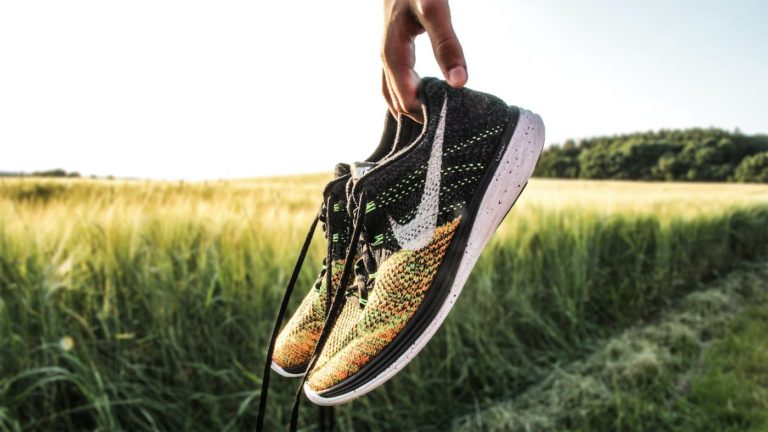Last updated on December 17th, 2021
Every time you pound the pavement (or the trails), your shoes take a beating.
A few months in, the cushy foam gets compressed under the load, and the outsoles begin to go bald, losing their ability to protect your body from the repetitive pounding. This only means one thing: it’s time to look for a new pair.
I know it’s hard to pull the plug on a beloved pair of shoes, but when they’re past their prime, they start to hurt more than they can help. Research shows that worn-down shoes may force runners to change their gait and posture, which can increase injury risk down the road.
In today’s post, I’ve compiled a list of signs to look out for when your trainers are truly worn-out and tips to make your favorite pair of running shoes last longer.
Sounds great?
Let’s get started.
How Should Your Running Shoes Last?
Estimates on running shoe lifespan vary, but as a general guideline, they should last between 400 and 500 miles before they’re compromised.
So it’s a matter of miles, not a matter of time—though through a little math you can guesstimate how many months a pair of shoes should last you.
That said, this rule isn’t written in stone. In fact, a shoe’s wear rate varies drastically for every runner, depending on many factors. Let’s briefly touch on a few.
- Your Running Style. Foot strike also impacts overall shoe wear. If you doubt it, take a look at the bottom of a worn-out pain and see what section has the most damage: front, middle, or heel. Knowing this also helps find shoes that better suit your running style.
- Your body weight. The heavier you are, the more impact the effect of gravity has on your running shoes. This can speed up the rate of the deterioration of the shoe structure.
A lighter runner may get the full 500 miles of out of a running pair because the impact forces with each foot strike are way less than a heavier runner.
- Your typical running terrain. You’ll wear down your shoes faster if you typically run on rough surfaces in comparison to someone who does most of their training on the treadmill.
How To Keep Track of Your Running Shoes’ Lifespan
Here are the measures you need to take to ensure that you replace your running shoes at the right time.
Track Your Mileage
The best way to make sure you’re not running in worn-out kicks is to abide by the 400 to 500 miles guideline. To make it happen, keep track of the mileage of your shoes.
It’s simple to figure out when you approach the 400 to 500-mile range if you are tracking your runs with a smartphone app or a GPS watch. Otherwise, you can guesstimate based on how much you run each week.
Let’s say you’re of average height and weight and run about 8 miles per week, then you should hunt for a new pair every 10 to 12 months.
However, if you log more miles (like me), then look at replacing your running shoes much more often.
Check for Work Outsoles
One of the clearest signs that it’s time for a new pair of running shoes is worn-out treads, especially on the outsole. The outsole is the most durable part of the shoe. So the moment it wears away, you’ve undoubtedly lost all of the support and cushioning. This is especially the case when the outsole has fissures or cracks.
Don’t postpone getting new running shoes until you can visibly see the signs that your shoes are breaking apart. It will be too late by that time.
You’re Feeling Pain
Along with the signs of physical wear on your shoes, you should also listen to your body–especially after your runs.
If you start to experience pain in the feet, shins, or lower back, it could mean it’s time to get new shoes.
It doesn’t have to be a serious injury—even black toenails or persistent blisters should indicate the workings of worn-out shoes.
Tips To Make Your Running Shoes Last Longer
Although eventually, your shoes will be out of commission, you don’t want to send them to early retirement by not taking good care of them.
- Use your shoes exclusively for running. If you run errands, instead of quality miles, in your running shoes, you’ll shorten their lifespan. Only use your running shoes when pounding the pavement and get separate shoes for other daily activities.
- Rotate. Having more than one pair at a time distributes the stress you place on them so each pair lasts longer. By changing up your footwear, you may prevent overtaxing any one muscle, bone, tendon, or ligament while simultaneously strengthening others.
- Use the right shoes for the terrain. Road running shoes were designed to run on the pavement while trail shoes were made for the trail.
- Change up your surfaces. Instead of sticking to the same terrain, especially if it’s the sidewalk, take your runs to different surfaces. I’d recommend softer surfaces, such as grass or trail paths, to preserve your kicks.
About the author: David Dack is an established fitness blogger and running expert. When he’s not training for his next marathon, he’s doing research and trying to help as many people as possible to share his fitness philosophy. Check his blog Runners Blueprint for more info.

